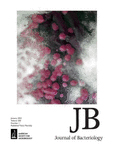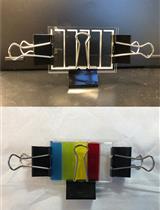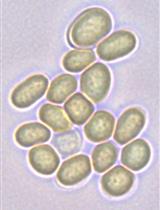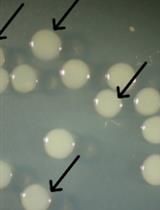- EN - English
- CN - 中文
Glucose Starvation, Magnesium Ion Starvation, and Bile Stress Assays
葡萄糖饥饿、镁离子饥饿和胆汁应激分析
发布: 2021年09月20日第11卷第18期 DOI: 10.21769/BioProtoc.4157 浏览次数: 2890
评审: Alexandros AlexandratosElizabeth LibbyAnonymous reviewer(s)
Abstract
Salmonella enterica serovar Enteritidis (S. Enteritidis) is a leading causative pathogen for food-borne gastroenteritis. During its course of infection, it confronts myriads of physiological barriers inside the host, such as nutrient deprivation, low micronutrient availability, and toxicity from bile salts, to promote bacterial survival and infection inside the host. The ability of the pathogen to overcome these stressful conditions determines the degree of virulence in the host. Therefore, assessment of the survival of a pathogen during different stress conditions, like glucose starvation, magnesium starvation, and bile stress, are important parameters to assess the virulence of the pathogen. Here, we describe protocols for estimating the survival of the pathogen during the above-mentioned stress conditions. We culture S. Enteritidis in an appropriate growth medium to a required O.D.600 and treat it with glucose starvation (M9 minimal culture medium containing 0.03% glucose), magnesium starvation (M9 minimal culture medium containing 20 µM MgSO4), and bile stress (bacterial cells treated with 15% bile salts in Luria Bertani (LB) culture medium) conditions. The number of surviving bacteria is obtained after the treatment by calculating the colony-forming units (CFU) of the surviving pathogen obtained on LB agar plates at relevant time intervals. The experiments are performed in biological replicates, and statistical analysis is performed to validate the experimental findings. The methodology of these stress response assays is simple and can be adapted to study the pathogenesis and stress response in other relevant and culturable enteric pathogens.
Keywords: Food-borne gastroenteritis (食源性肠胃炎)Background
Salmonella enterica serovar Enteritidis (S. Enteritidis) is one of the four leading enteric pathogens that cause food-borne gastroenteritis. About 93 million infections are reported every year caused as a result of non-typhoidal salmonellosis (Balasubramanian et al., 2018). It poses a severe clinical and economic burden, especially in developing countries, due to poor sanitation, hygiene, and improper food sterilization practices. Approximately 155,000 deaths are reported worldwide every year arising from non-typhoidal salmonellosis (Balasubramanian et al., 2018). During infection by S. Enteritidis, the pathogen confronts a wide range of physiological barriers or stress factors in the host system, such as temperature, antimicrobial peptides, nutrient-starved conditions (e.g., glucose limitation in the gut), micronutrients (e.g., Mg2+, Mn2+, Ca2+, and Fe3+) starvation, high osmolarity and hypoxia, bile salts, and oxidative and nitrosative stresses (Fang et al., 2016). The pathogen employs a set of stress responses and virulence genes to survive during these hostile conditions that indirectly determine its resilience during host-pathogen interactions (Fang et al., 2016). In particular, stress factors like glucose starvation are encountered by the pathogen in the anaerobic environment of the gut (Bowden et al., 2009; Arunima et al., 2020a). Mg2+ starvation conditions are encountered within the phagocytic environment (Connor et al., 2009; Choi et al., 2019; Arunima et al., 2020a and 2020b), and Bile salts are encountered as the pathogen transits through the liver and small intestine during infection (Spector et al., 1999; Kenyon et al., 2002 and 2005; Rychlik and Barrow, 2005; Álvarez-Ordóñez et al., 2011; Hernández et al., 2012; Arunima et al., 2020a). While these host factors exert antimicrobial effects on pathogen survival during infection (Fang et al., 2016), Salmonella serovars are known to overcome these stressful conditions (Rychlik and Barrow, 2005). The ability of the pathogen to survive these factors has been previously documented to determine the degree of virulence within the host system (GarcíaVéscov et al., 1996; Merritt and Donaldson, 2009; Waligora et al., 2014; Arunima et al., 2020a and 2020b). Hence, assessing survival during glucose and Mg2+ starvation and bile stress is critical to studying the pathogenesis of Salmonella infection.
In this article, we have described the protocols for assessing the survival of S. Enteritidis and its derivative strains during glucose starvation, Mg2+ starvation, and bile stress, to phenotypically understand the role of genetic factors that can contribute to its stress responses. To note, the protocols have been widely adopted in our previously published work (Arunima et al., 2020a and 2020b), and similar techniques were implemented in work by others (GarcíaVéscov et al., 1996; Soncini et al., 1996; Groisman et al., 1997; Spector et al., 1999; Kenyon et al., 2002 and 2005; Prouty et al., 2004; Abdallah et al., 2007; Merritt and Donaldson, 2009; Hernández et al., 2012; Moreira et al., 2013; Lofton et al., 2014). Here, we provide the protocols to estimate the survival of S. Enteritidis following treatment with these stresses in vitro to facilitate their adoption by the scientific community. The methodology of these stress response assays is simple and can be expanded to study the stress response in other relevant and culturable enteric pathogens.
Materials and Reagents
0.22 µm pore Size, PVDF Sterile hydrophilic syringe membrane filter (Merck, Millex® 33 mm PVDF 0.22 µm Sterile RUO, catalog number: SLGVR33RS)
15 ml Sterile Falcon tubes (Tarsons, Sterile Centrifuge Tube Conical Bottom, catalog number: 546021)
50 ml Sterile Falcon tubes (Tarsons, Sterile Centrifuge Tube Conical Bottom, catalog number: 546041)
1.5 ml Microcentrifuge tubes (Tarsons, Polypropylene Spinwin Micro Centrifuge Tube 1.5 ml, catalog number: 500010)
1.5 ml Microcentrifuge tubes rack (Scientific Research & Instruments, 1.5 ml Microcentrifuge Tubes Places 24 (6 × 4 Array), catalog number: P20201)
Pipette Tips (Tarsons, Micro Tips, catalog numbers: 521000, 521010, 521020)
90 mM Disposable Petri Dishes (Tarsons, Petri dish Radiation Sterile 90 mm, catalog number: 460095)
Borosilicate glass rim culture tubes (Borosil, 18 × 150 mm Culture Tubes with Rim, catalog number: 9800U06)
Salmonella enterica serovar Enteritidis str. P125109
Ethanol pure ≥99.5% (Himedia, catalog number: MB106)
Agar Agar (Himedia, Agar Agar, Type I, catalog number: GRM666)
Streptomycin Sulfate (Himedia, catalog number: CMS220)
Casamino acids (Himedia, Casein Enzyme Hydrolysate, catalog number: CR014)
Glucose (Himedia, D-(+)-Glucose anhydrous, catalog number: MB037)
CaCl2·2H2O (Sigma-Aldrich, catalog number: C3306)
MgSO4·7H2O (Sigma-Aldrich, catalog number: M2773)
Bile salts (Himedia, catalog number: RM009)
Na2HPO4·7H2O (Himedia, catalog number: GRM1417)
KH2PO4 (Sisco Research Laboratories Pvt. Ltd.(SRL), catalog number: 52403)
NaCl (Fisher Scientific, catalog number: 27605)
NH4Cl (Sisco Research Laboratories Pvt. Ltd.(SRL), catalog number: 96452)
KCl (Fisher Scientific, catalog number: 19255)
Sterile 1 M MgSO4 solution (see Recipes)
Sterile 1 M CaCl2 solution (see Recipes)
Sterile 20 % Glucose (see Recipes)
Sterile 20 % Casamino acids (see Recipes)
Sterile 5× M9 salt see Recipes)
Sterile M9 minimal medium (see Recipes)
Sterile M9 minimal medium containing 0.03% glucose (see Recipes)
Sterile M9 minimal medium containing 20 µM MgSO4 (see Recipes)
50 mg/ml Streptomycin Sulfate solution (see Recipes)
Sterile 1× Phosphate-buffered saline (PBS) buffer (see Recipes)
30% Bile Salts (see Recipes)
Luria Bertani (LB) medium (Himedia, Luria Bertani Broth, Miller, catalog number: M1245) (see Recipes)
LB agar (see Recipes)
Equipment
Hand Tally Counter (Humboldt, catalog number: H-9700)
Pipettes EP-2.5, EP-20, EP-200, EP-1000 (Eppendorf, Research® 2100 Series single channel adjustable volume pipettes, model: 0.1-2.5 µl, 2-20 µl, 20-200 µl, 100-1,000 µl)
-20°C refrigerator (CelFrost, catalog number: BFS-150) and 4°C refrigerator (LG, catalog number: GL-T402LPZU)
250 ml borosilicate glass conical flask with screw caps (Borosil, Conical With Screw Cap Flasks Capacity 250 ml, catalog number: 5021021)
500 ml and 250 ml borosilicate glass reagent bottles (Borosil, catalog numbers: 1501024, 1501021)
500 ml borosilicate glass beaker (Borosil, catalog number: BRL_1000D24)
Autoclavable beaker (Tarsons, catalog number: 422040)
500 ml and 100 ml measuring cylinder (Tarsons, catalog numbers: 345060, 345040)
Stirring hotplate
Autoclave (Osworld Scientific Equipments Pvt. Ltd, Osworld, Autoclave Vertical Top Opening Steam Sterilizer, OAT G – 125)
Burner
Biosafety cabinet (Nuaire, Class II Biosafety Cabinet Sliding Window, model: NU-425-600S)
Incubator for bacterial culture at stable temperature (Eppendorf, New BrunswickTM Innova® 42 R Incubator, and Refrigerated Shaker, catalog number: M1335-0016)
Centrifuge (Eppendorf, model: 5424 R)
Spectrophotometer (Agilent Cary 60 UV-visible light (UV-Vis) spectrophotometer)
Inoculating turntable (ISOLAB Laborgeräte GmbH, catalog number: 6286850)
Metal rod cell spreader (Fisher Scientific, catalog number: 08-769-2B)
Inoculation loop (Himedia, model: LA023)
Software
GraphPad Prism v. 7.0
Microsoft® Excel
Procedure
文章信息
版权信息
© 2021 The Authors; exclusive licensee Bio-protocol LLC.
如何引用
Arunima, A. and Suar, M. (2021). Glucose Starvation, Magnesium Ion Starvation, and Bile Stress Assays. Bio-protocol 11(18): e4157. DOI: 10.21769/BioProtoc.4157.
分类
微生物学 > 微生物生理学 > 适应
环境生物学 > 细菌
生物科学 > 微生物学
您对这篇实验方法有问题吗?
在此处发布您的问题,我们将邀请本文作者来回答。同时,我们会将您的问题发布到Bio-protocol Exchange,以便寻求社区成员的帮助。
Share
Bluesky
X
Copy link













